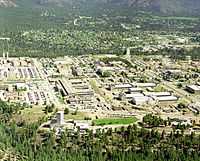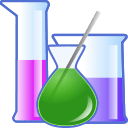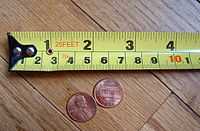Laboratory

Los Alamos National Laboratory Credit: Los Alamos National Laboratory.
A laboratory is a construct you create so as to produce reproducible measurements.
Theoretical laboratory
Def. "a room, building or institution equipped for scientific research, experimentation or analysis"[1] is called a laboratory.
Conditions
Laboratory conditions are often expressed in terms of standard temperature and pressure.
"Standard condition for temperature and pressure are standard sets of conditions for experimental measurements established to allow comparisons to be made between different sets of data. The most used standards are those of the International Union of Pure and Applied Chemistry (IUPAC) and the National Institute of Standards and Technology (NIST), although these are not universally accepted standards. Other organizations have established a variety of alternative definitions for their standard reference conditions."[2]
"In chemistry, IUPAC established standard temperature and pressure (informally abbreviated as STP) as a temperature of 273.15 K (0 °C, 32 °F) and an absolute pressure of 100 kPa (14.504 psi, 0.986 atm, 1 bar),[3] An unofficial, but commonly used standard is standard ambient temperature and pressure (SATP) as a temperature of 298.15 K (25 °C, 77 °F) and an absolute pressure of 100 kPa (14.504 psi, 0.986 atm). The STP and the SATP should not be confused with the standard state commonly used in thermodynamic evaluations of the Gibbs free energy of a reaction."[2]
"Standard conditions for gases: Temperature, 273.15 K [...] and pressure of 105 pascals. The previous standard absolute pressure of 1 atm (equivalent to 1.01325 × 105 Pa) was changed to 100 kPa in 1982. IUPAC recommends that the former pressure should be discontinued."[3]
"NIST uses a temperature of 20 °C (293.15 K, 68 °F) and an absolute pressure of 101.325 kPa (14.696 psi, 1 atm). The International Standard Metric Conditions for natural gas and similar fluids are 288.15 K (59.00 °F, 15.00 °C) and 101.325 kPa.[4]"[2]
Measurements
Def. any act of quantifying relative to a standard is called a measurement.
Original research
Hypothesis:
- A laboratory can be set up in virtual space to test reality for reproducibility.
See also
References
- ↑ "laboratory, In: Wiktionary". San Francisco, California: Wikimedia Foundation, Inc. September 21, 2013. Retrieved 2013-09-30.
- 1 2 3 "Standard conditions for temperature and pressure, In: Wikipedia". San Francisco, California: Wikimedia Foundation, Inc. June 16, 2012. Retrieved 2012-06-16.
- 1 2 Alan D. McNaught, Andrew Wilkinson (1997). Compendium of Chemical Terminology, The Gold Book (2nd ed.). Blackwell Science. ISBN 0-86542-684-8. http://books.google.com/books?id=dO5qQgAACAAJ&hl=en.
- ↑ Natural gas – Standard reference conditions (ISO 13443). Geneva, Switzerland: International Organization for Standardization. 1996. http://www.iso.org/iso/iso_catalogue/catalogue_tc/catalogue_detail.htm?csnumber=20461.
External links
| Humanities resources |
|---|
| | Activities | | | | Articles | | | | Categories |
Agriculture ·
Anthropology ·
Archaeology ·
Art ·
Arts ·
Culture ·
Dominant group ·
Education ·
Genetics ·
History ·
Humanities ·
Language ·
Linguistics ·
Literature ·
Medicine ·
Philosophy ·
Psychology ·
Religious studies ·
Semantics ·
Social psychology
| | | Courses | | | | Fields | | | | Glossaries | | | | Lectures | | | | Lessons |
| | | Lists |
| | | Original research | | | | Portals |
History ·
Social sciences
| | | Problem sets | | | | Projects | | | | Proposals | | | | Quizzes | | | | Schools |
Agriculture ·
Alternative medicine ·
Anthropology ·
Archeology ·
Classics ·
Dentistry ·
Gastronomy ·
History ·
Life ·
Medicine ·
Pharmacy ·
Veterinary medicine
| | | Topics | |
|
| Mathematics resources |
|---|
| | Activities | | | | Articles | | | | Categories |
Algebra ·
Algorithms ·
Analysis ·
Applied mathematics ·
Arithmetic ·
Basic mathematics ·
Calculus ·
College algebra ·
Complex analysis ·
Complex Function Theory ·
Complex numbers ·
Discrete mathematics ·
Drilling and threading ·
Elementary mathematics ·
Equations ·
Finite element analysis ·
Finite element software ·
Floating point ·
Formulas ·
Functional analysis ·
Functions ·
Further Study, College Algebra ·
Further Study, Introduction to Limits ·
Geomathematic ·
Geometry ·
Introduction to Topology ·
Laboratory on Mathematics and Mathematics Education ·
Mathematical analysis ·
Mathematical physics ·
Mathematical proofs ·
Mathematical theorems ·
Mathematics Media ·
Numerical analysis ·
Numerical methods ·
Olympiads ·
Philosophy of mathematics ·
Pre-Calculus ·
Probability ·
Proofs ·
Pure Mathematics ·
Real numbers ·
Representation theory ·
School of Mathematics ·
Secondary Math Courses ·
Secondary Math Lessons ·
Secondary Math Quizzes ·
Systems theory ·
Trigonometry ·
Units of measurement
| | | Courses | | | | Glossaries | | | | Lectures | | | | Lessons | | | | Lists | | | | Portals | | | | Problem sets | | | | Projects | | | | Quizzes | | | | Schools |
Biomathematics ·
Mathematics
| | | Topics | |
|
| Medicine resources |
|---|
| | Activities | | | | Articles | | | | Categories |
Anatomy ·
Anesthesiology ·
Basic sciences ·
Blood tests ·
Cardiovascular medicine ·
Clinical Skills ·
Clinical trials ·
Complementary and alternative medicine ·
Dentistry ·
Dermatology ·
Diseases ·
Emergency Medicine ·
Endocrinology ·
Evidence-based Medicine ·
Gastroenterology ·
Geriatric medicine ·
Gerontology ·
Health ·
Healthcare ·
Hematology ·
Medical biophysics ·
Medical emergencies ·
Medical physics ·
Medical subject headings ·
Medicinal plants ·
Medicinal plants and wild foods ·
Medicine ·
Medicine stubs ·
Military Medicine ·
Nephrology ·
Neuroprotection ·
Oncology ·
Ophthalmology ·
Orthopedics and Rheumatology ·
Otolaryngology ·
Otorhinolaryngology ·
Pain ·
Pathology ·
Pharmacy ·
Physiology ·
Podiatry ·
Primary Care Medicine ·
Proctology ·
Psychiatry ·
Regenerative medicine ·
Reproductive medicine ·
Respiratory medicine ·
Risk management ·
School of Medicine Brainstorming ·
Urology
| | | Courses | | | | Glossaries | | | | Lectures | | | | Lessons | | | | Lists | | | | Problem sets | | | | Projects |
Gene Project ·
Medicine/Projects
| | | Quizzes | | | | Schools |
Medicine/Schools ·
Alternative medicine ·
Biology ·
Dentistry ·
Gastronomy ·
Medicine ·
Nursing ·
Pharmacy ·
School Health ·
Veterinary medicine ·
Zoology
| | | Syndromes | | | | Topics |
Medicine/Topics ·
Anesthesiology ·
Angiology ·
Anatomy ·
Basic sciences ·
Biology ·
Biomedical gerontology ·
Biomedicine ·
Cardiovascular medicine ·
Chemistry ·
Clinical skills ·
Community medicine ·
Cytogenetics ·
Emergency Medicine ·
Endocrinology ·
Epidemiology ·
Evidence-based Medicine ·
Gastroenterology ·
General surgery ·
Genetics ·
Geriatric Medicine ·
Health Informatics ·
Hematology ·
Histology ·
Immunology ·
Internal medicine ·
Laboratory Techniques ·
Medical physics ·
Medicinal botany ·
Medicinal chemistry ·
Military medicine ·
Nephrology ·
Neurology ·
Oncology ·
Ophthalmology ·
Orthopedics and Rheumatology ·
Otorhinolaryngology ·
Pathology ·
Pediatric Medicine ·
Pharmacology ·
Physiology ·
Primary Care Medicine ·
Psychiatry ·
Psychology ·
Regional Anatomy ·
Reproductive Medicine ·
Respiratory Medicine ·
Rheumatology ·
Serology ·
Virology ·
|
|
| Sciences resources |
|---|
| | Activities | | | | Articles | | | | Categories |
Anthropology ·
Archaeology ·
Astronomy ·
Astronomy Images ·
Astrophysics ·
Atmospheric science ·
Biochemistry ·
Biology ·
Botany ·
Chemistry ·
Climatology ·
Computer science ·
Cosmology ·
Earth science ·
Ecology ·
Economics ·
Epistemology ·
Etymology ·
Genetics ·
Geography ·
Geology ·
History of science ·
Immunology ·
Linguistics ·
Materials science ·
Mathematics ·
Metallurgy ·
Paleontology ·
Physics ·
Planetary Science ·
Plant sciences ·
Political science ·
Psychology ·
Sciences ·
Semantics ·
Schools ·
Sciences ·
Social psychology ·
Sociology ·
Statistics ·
Technology ·
Zoology
| | | Courses | | | | Glossaries | | | | Lectures |
Astronomy/Lectures ·
Biology/Lectures ·
Chemistry/Lectures ·
Ecology/Lectures ·
Geography/Lectures ·
Geology/Lectures ·
Physics/Lectures ·
Sciences/Lectures
| | | Lessons | | | | Lists | | | | Problem sets | | | | Projects | | | | Quizzes | | | | Topics |
Sciences/Topics ·
Archeology ·
Astronomy ·
Astrophysics ·
Cosmology ·
Earth science ·
Genetics ·
Geophysics ·
Materials science ·
Oceanography ·
Paleontology ·
Physics ·
Planetary science
|
|
| Technology resources |
|---|
| | Activities | | | | Articles | | | | Categories |
Astronomy ·
Astronomy Project ·
Astrophysics ·
Atmospheric science ·
History of science ·
Physics and Astronomy ·
Planetary Science ·
Technology
| | | Courses | | | | Glossaries |
| | | Lectures | | | | Lessons |
| | | Lists |
| | | Problem sets | | | | Projects | | | | Quizzes | | | | Schools | | | | Topics |
Amateur astronomy ·
Astronomy ·
Astrophysics ·
Geophysics ·
Nuclear physics ·
Particle physics
|
|
 This is a research project at http://en.wikiversity.org
This is a research project at http://en.wikiversity.org
 |
Educational level: this is a research resource. |
 |
Resource type: this resource is an article. |
 |
Resource type: this resource contains a lecture or lecture notes. |
.jpg) |
Subject classification: this is a humanities resource. |
 |
Subject classification: this is a science resource . |
 |
Subject classification: this is a technology resource . |


![]() This is a research project at http://en.wikiversity.org
This is a research project at http://en.wikiversity.org